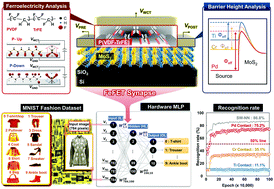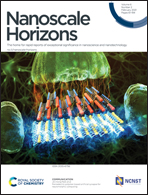Ferroelectric polymer-based artificial synapse for neuromorphic computing†
Abstract
Recently, various efforts have been made to implement synaptic characteristics with a ferroelectric field-effect transistor (FeFET), but in-depth physical analyses have not been reported thus far. Here, we investigated the effects by (i) the formation temperature of the ferroelectric material, poly(vinylidene fluoride-trifluoroethylene) P(VDF-TrFE) and (ii) the nature of the contact metals (Ti, Cr, Pd) of the FeFET on the operating performance of a FeFET-based artificial synapse in terms of various synaptic performance indices. Excellent ferroelectric properties were induced by maximizing the size and coverage ratio of the β-phase domains by annealing the P(VDF-TrFE) film at 140 °C. A metal that forms a relatively high barrier improved the dynamic range and nonlinearity by suppressing the contribution of the tunneling current to the post-synaptic current. Subsequently, we studied the influence of the synaptic characteristics on the training and recognition tasks by using two MNIST datasets (fashion and handwritten digits) and the multi-layer perceptron concept of neural networks.

- This article is part of the themed collections: Nanoscale Horizons 10th anniversary regional spotlight collection: Asia-Pacific, 2021 Horizons Outstanding Paper Award Winners, Nanoscale Horizons 2022 Lunar New Year Collection and Nanoscale Horizons Most Popular 2021 Articles


 Please wait while we load your content...
Please wait while we load your content...